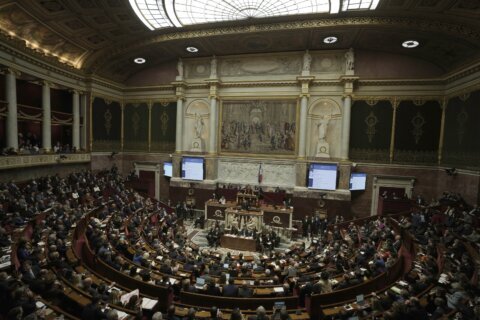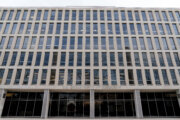TASITOLU, East Timor (AP) — An estimated 600,000 people — nearly half of East Timor’s population —- packed a seaside park Tuesday for Pope Francis’ final Mass, held on the same field where St. John Paul II prayed 35 years ago during the nation’s fight for independence from Indonesia.
The remarkable turnout was a testament to the overwhelmingly Catholic Southeast Asian country and the esteem with which its people hold the church, which stood by the Timorese in their traumatic battle for freedom and helped draw international attention to their plight.
Francis delighted them on Tuesday, staying at Tasitolu park until well after nightfall to loop around the field in his open-topped popemobile, with the screens of the crowd’s cellphones lighting up the evening.
“I wish for you peace, that you keep having many children, and that your smile continues to be your children,” Francis said in his native Spanish.
Other papal Masses have drawn millions of people in more populous countries, such as the Philippines, and there were other nationalities represented at Tuesday’s Mass. But the crowd in East Timor, population 1.3 million, was believed to represent the biggest turnout for a papal event ever, in terms of the proportion of the national population.
The Tasitolu park was a sea of yellow and white umbrellas — the colors of the Holy See flag — as Timorese shielded themselves from the afternoon sun awaiting Francis’ arrival. They got occasional spritzes of relief from water trucks that plied the field with hoses.
“We are very happy that the pope came to Timor because it gives a blessing to our land and our people,” said Dirce Maria Teresa Freitas, 44, who arrived at the field at 9 a.m. from Baucau, more than seven hours early.
Tasitolu is said to have been a site where Indonesian troops disposed of bodies killed during their 24-year rule of East Timor. As many as 200,000 people were killed over a quarter-century. Now it is known as the “Park of Peace” and features a larger-than-life-sized statue of John Paul to commemorate his Oct. 12, 1989 Mass, when the Polish pope shamed Indonesia for its human rights abuses and encouraged the overwhelmingly Catholic Timorese faithful.
Francis was following in John Paul’s footsteps during his visit to cheer on the nation two decades after it became independent in 2002. East Timor, known also as Timor-Leste, remains one of the poorest countries, with some 42% living below the poverty line, according to the U.N. Development Program.
But the Timorese are deeply faithful — some 97% are Catholic ever since Portuguese explorers first arrived in the early 1500s.
Cardinal Carmo da Silva, the archbishop of Dili, told the crowd at the end of the Mass that John Paul’s visit “marked the decisive step in our process of self-determination,” and that Francis’ visit to the same place “marks a fundamental step in the process of building our country, its identity and its culture.”
In the days leading up to Francis’ trip, authorities said some 300,000 people had registered through their dioceses to attend the Mass, but President Jose Ramos-Horta said he expected 700,000 and the Vatican had predicted as many as 750,000.
Once the Mass got under way, Vatican spokesman Matteo Bruni cited crowd estimates by local organizers that 600,000 people were attending in the Tasitolu park and surrounding areas.
They lined up before dawn to enter the park, on the coast about 8 kilometers (nearly 5 miles) from downtown Dili. With hours to go until the service, the roads leading to it were jammed by cars, trucks and buses packed with people; others walked down the middle of the street, ignoring the sidewalks. Temperatures reached 31 degrees Celsius (88 degrees Fahrenheit), and felt even hotter with humidity over 50%.
“For us, the pope is a reflection of the Lord Jesus, as a shepherd who wants to see his sheep, so we come to him with all our hearts as our worship,” said Alfonso de Jesus, who also came from Baucau, the country’s second-largest city after Dili.
De Jesus, 56, was among the estimated 100,000 people who attended John Paul’s 1989 Mass, which made headlines around the world because of a riot that broke out just as it was ending. John Paul looked on as baton-wielding Indonesian plainclothes police clashed with some 20 young men who shouted “Viva a independência” and “Viva el Papa!”
According to Associated Press reporting at the time, the men unfurled a banner in front of the altar and hurled chairs at police. One banner read “Fretilin Welcomes You,” a reference to the independence movement that fought Indonesian rule since East Timor was annexed in 1976 after Portugal dismantled its centuries-old colonial empire.
Four women were reported hospitalized with injuries suffered after being crushed in the surging crowd. The pope wasn’t harmed. Amnesty International later expressed concern that some 40 people had been detained and tortured, though Indonesian authorities at the time denied any arrests or torture.
“The Mass was run very neat and orderly with very tight security,” De Jesus recalled more than three decades later. “But it was crushed by a brief riot at the end of the event.”
Many of the reports at the time quoted Dili Bishop Carlos Ximenes Belo in trying to draw attention to the plight of the Timorese people. Belo would go onto win the Nobel Peace Prize with Ramos-Horta for their efforts to peacefully resolve the Timorese conflict.
But Belo has since had his legacy tarnished, at least outside of East Timor, after the Vatican revealed in 2022 that he had been sanctioned for sexually abusing young boys. Now living in Portugal and blocked by the Vatican from having contact with East Timor, Belo’s historic role has been seemingly erased from any official mention during Francis’ visit, even while ordinary Timorese still revere him as a hero.
Sister Maria Josefa, a nun from Cape Verde who has lived in Dili for five years, said Francis was right to speak out generally about “abuse” when he arrived in Dili on Monday, saying his were words of compassion, even if he didn’t mention Belo by name.
“Unfortunately, the church is made of saints and sinners, but the pope left it within the open that God does not allow for such practices,” she said. “We simply need to correct, to understand those who fell and also try to lift those who have endured such torture.”
___
AP researcher Randy Herschaft contributed from New York.
___
Associated Press religion coverage receives support through the AP’s collaboration with The Conversation US, with funding from Lilly Endowment Inc. The AP is solely responsible for this content.
Copyright © 2025 The Associated Press. All rights reserved. This material may not be published, broadcast, written or redistributed.





